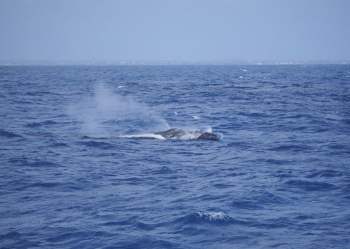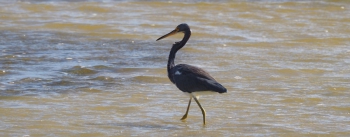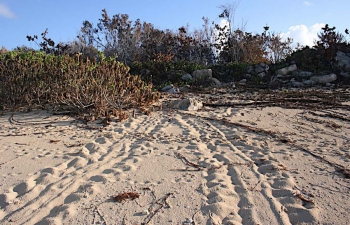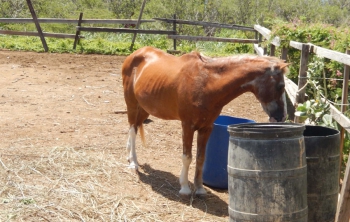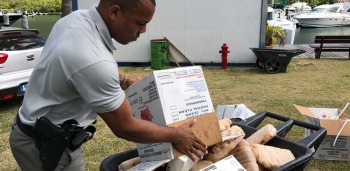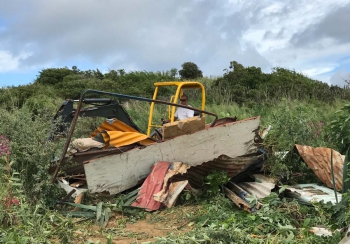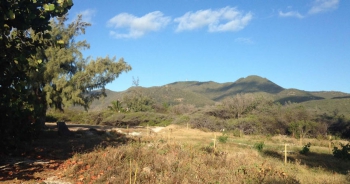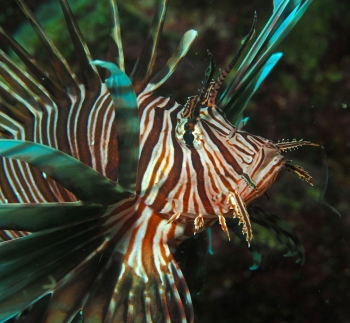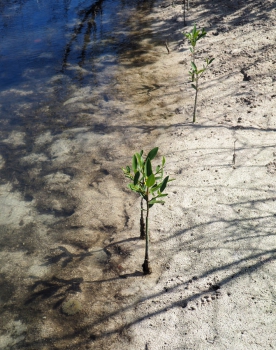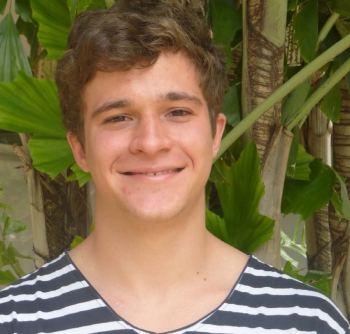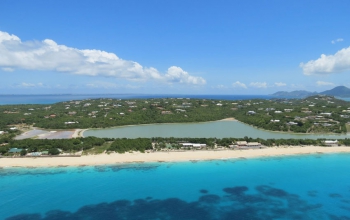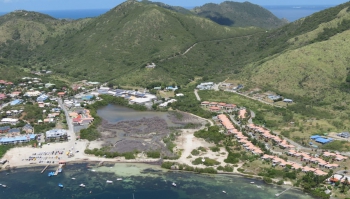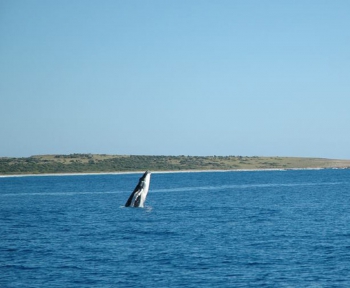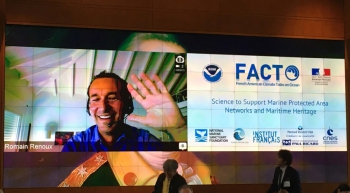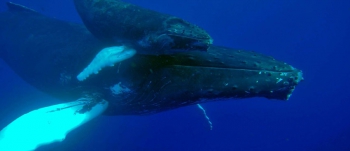- page 3 : L’amélioration des connaissances sur les espaces et les espèces protégées
- page 9 : La maîtrise des impacts anthropiques sur les espaces protégés
- page 11 : Actions de police
- page 13 : La restauration des milieux et des populations dégradés
- page 15 : L’optimisation des moyens pour assurer la qualité des missions
- page 17 : La communication et l’éducation environnementale
- page 18 : Le renforcement de l’intégration régionale
Newsletter-28
Newsletter-28
Better Knowledge About Protected Areas And Protected Species
The third MEGARA scientific mission took place on March 13-17, 2017, and included placing an Argos beacon in the fatty tissue of one humpback whale and taking skin samples from two such whales. In contrast to the beacons placed in 2014, this most recent one does not emit anything for the moment.
The skin samples will allow scientists to determine the origin of each of these individuals. The samples will be compared by Dr Palsboll at the University of Groningen in The Netherlands, using a database of 8,500 samples taken from whales in the Northern Atlantic, while prior results lead to the supposition that the whales in Saint Martin belong to a group also found off the coast of Cape Verde. Strong swells generated by the wind made the navigational conditions difficult for this mission, but all the same, allowed for the observation of at least 10 humpback whales, including two calves. These observations were made from aboard a catamaran, used as base camp, with closer approaches made in the semi-rigid dinghy of the Réserve Naturelle, primarily around Tintamare and Anguilla. Underwater listening via hydrophone provided interesting acoustical information, confirming that the humpback whales are not only migrating through the waters of the Northern Islands, but also come here to reproduce, as indicated by the songs of the males. The Réserve Naturelle organized this mission with technical support from the association, Megaptera, and the participation of Olivier Raynaud and Claire Delubria from the Territorial Environmental Agency of Saint Barthélemy. Michel Vély, president of Megaptera, is very pleased to now be based in Saint Martin. «This proximity will allow us to develop projects dedicated to additional species of marine mammals throughout the year, improve our overall knowledge, and give the public the possibility to learn more about these animals,” he says, pointing out that he is especially looking forward to working in synergy with the association «Mon école, ma baleine» (My School, My Whale), which can organize student field trips at sea. Good news: The Réserve is organizing a conference in the near future at which the public can see a very good 33-minute film directed by Jérôme Grenèche during the 2014 Megara mission in the Northern Islands
Deep in the seas of the Réserve Naturelle, 15 meters below the surface, a microphone records all of the sounds heard underwater.
And there are lots of them. Natural sounds coming from shrimp, fish, or marine mammals — the primary species concerned by this experience — but also any sound pollution created by humans, such as the noise of motors or that of seismic prospecting. The sound-recording device is programmed to start every four hours, and capture all the decibels it hears over the next hour. Three American researchers from the National Oceanic and Atmospheric Administration (NOAA) and a researcher from the University of Florida , who has set up similar projects on the other French Caribbean islands, installed the microphone in December 2016. These four scientists are working on CHAMP — Caribbean Humpback Acoustic Monitoring Program — a study of humpback whales and other marine mammals. Once the recording devices are collected, an analysis of their data provides information about the species of marine mammals that are heard in relation to the frequency and signature of the sounds. As for the humpback whales, it will eventually be possible to distinguish the number of individual “singers”, as each one has a personal voice in the midst of a common refrain, which itself changes every year.
1250 birds — 340 of which were black-necked stilts — were sighted in just two mornings in April 2016 at nine of the salt ponds on the island.
This data was collected during the annual campaign to study the ponds and the birds that visit them, as run by Caroline Fleury and Ashley Daniel. A large number of these birds migrate in the autumn and come south from North America, and head back in the spring to more northern latitudes, certain of which are 6,000 kilometers from Saint Martin. Forty species of shore birds — those small waders that dig their beaks in the silt of the ponds to find their food — were observed, as well as the Bahama pintail, the only member of the duck family to live on the island year-round, in contrast to the four other species present only in the winter : the blue-winged teal, the Eurasian teal, the ruddy duck, and the ring-necked duck. The scientific study of these birds revealed a few unexpected surprises, including the observation of rare species, such as an American duck, a Wilson’s snipe, a ruff, and a hooded merganser. The lives of these birds are closely tied to that of the ponds, which are closely observed by the Réserve Naturelle. Photos taken at regular intervals show all kinds of changes : cutting of vegetation, landfill, the height and color of the water, while the level meters installed at the Etang de Chevrise, the Etang Guichard, the Etang de Grand-Case, and the Mare Lucas in Oyster Pond, also register changes in the height of the water.
The protection of the nests and eggs belonging to these birds is of essential importance, but children are often unaware of this and amuse themselves by breaking eggs found near the Etang de la Barrière. Result: only two baby birds were observed during the hatching period on this pond. Please note: the walking of domestic animals is forbidden in these wetlands, which are an officially protected biotope, with the goal of preserving the tranquility of popular reproduction areas for the island’s birdlife.
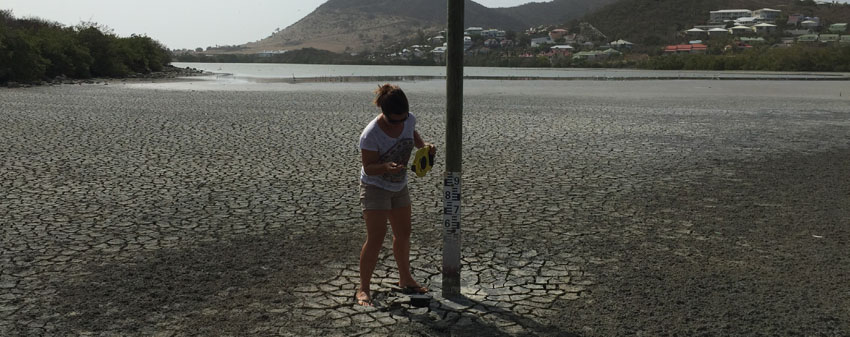
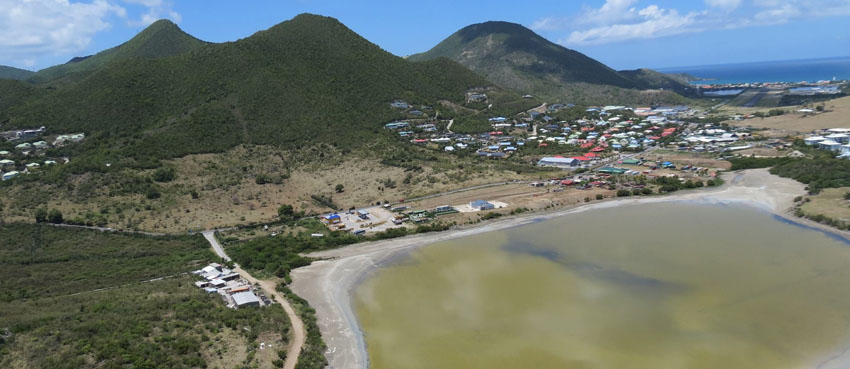
Managing The Impact Of Human Activities In Protected Areas
The report on the 2016 scientific study on the egg laying habits of sea turtles has been concluded. The 50 eco-volunteers completed 376 patrols on the beaches during the reproductive season, from April through November, and recorded 235 tracks made by turtles that came to lay their eggs in the sand, 169 of which were made by green turtles. 60% of the 235 traces were noted within two days of the turtle’s activity on the beach, thanks to the frequency of the patrols, and 53% of these sightings showed that eggs had been laid. As always, the beaches most preferred by the turtles are Long Bay (123 tracks), Plum Bay (40 tracks) and the two beaches on Tintamare (54 tracks). The results of this annual study, which was launched in 2009, confirmed which beaches are most visited by these turtles, so that the scientific team decided to prioritize the sites in a new way for the study in 2017. These results and this strategy were the subject for an evening presentation on February 14, to mark the debut of the 2017 egg-laying season for sea turtles in Saint Martin.
«Bayside» will remain a horseback riding center and will soon be back in business with a call for applications published in the press along with specifications as elaborated by the Réserve Naturelle and the Conservatoire du Littoral
This decision was validated during a meeting of the Council For French Shores In The Americas, held in Guadeloupe on February 1, 2017, as well as by the sites management committee for the Conservatoire. One recalls that the former owner was put on formal notice in 2016 by the Conservatoire du Littoral and asked to move from the location for having run a non-authorized commercial activity in an area classified as a nature reserve, as well as having modified the condition of the Réserve by doing work to the site. This person took his horses and moved out in January.
Police Activity
The Réserve Naturelle lent a helping hand to the environmental police from The National Office For Hunting and Wildlife to help recover a ton of frozen conch on January 27 at three different importers.
The importation of this species, protected since 1973 by the Washington Convention, is strictly controlled. The importer must be able to provide an invoice if the provenance of the conch is the European Union or benefit from a special importation authorization if the country is non-European. As the three importers implicated here had not made a request for such authorization, their merchandise was seized and dumped into the sea from the boat belonging to the Réserve Naturelle. They will also face paying a stiff fine.
There was a gardener, who also sold seashells, who set up shop without any permission along the edge of the Salines d’Orient, and was reported on June 17, 2015 for illegal occupation of land within the Réserve Naturelle, unauthorized destruction of classified land in a nature preserve, unauthorized agricultural and foresting activities in a nature preserve, and lastly unauthorized commercial and artisanal activities, once again in a nature preserve. After being identified thanks to security cameras during a robbery in Waikiki, this individual was taken to the gendarmerie, where he admitted he only had a temporary tourist visa and had resided illegally on the island for many years. Originally from Saint Lucia, he was sent back to his own island. The crew from the Réserve Naturelle cleaned up the land where he ran his business and had built the cabin where he lived. Two full dumpsters were evacuated to the Grandes Cayes eco-site.
Restoration Of Degraded Areas And Populations
The destruction of the former hotel at Galion left a large, open space that the Conservatoire had planned to revitalize for some time.
The idea was to plant various species of trees, before putting in picnic tables, which would benefit from the shade provided by the vegetation. The trees were planted in February and the species were selected from those traditionally found along the edges of the island’s beaches : sea grapes, wild pears, catalpas, and sea-buckthorns.
The current population of lionfish in the waters of the Réserve Naturelle is basically the same as last year.
Every lionfish that is seen is systematically caught by the staff, and it remains to be determined if this invasive species carries ciguatera or not. The analyses done to date have provided results too limited to make a definitive statement on this potential health risk.
Caroline Fleury and Ashley Daniel have replanted the mangrove seeds collected in October 2016 by sixth and seventh graders at Mont des Accords middle school at the Étang de la Barrière.
This environmental gesture will help accelerate the restoration of the mangroves, which suffered on the island during the long period of drought in 2015. The collection of the seeds was part of a field trip led by three representatives of the Réserve Naturelle to mark the 25th anniversary of the protection of sea turtles on all of the French Caribbean islands.
Better Means For Better Missions
Théo Tondu, né à Saint-Martin il y a 20 ans, a été accueilli à la Réserve naturelle pour un mois de stage, entre février et mars 2017.
Étudiant en métropole, il prépare un BTS pêche et gestion de l’environnement marin et a enrichi ses connaissances en travaillant avec le pôle scientifique de la Réserve naturelle, mais aussi en participant sur le terrain aux patrouilles avec les gardes. Sa mission principale a consisté à affiner la cartographie existante des différentes espèces de cactus dans la Réserve, notamment à Tintamare.
Nouvelle arrivée sur l’île, Jade Quéré est titulaire d’un Master 2 en communication des organisations.
Spontanément, elle a proposé à la Réserve naturelle de travailler bénévolement avec l’équipe en place afin d’améliorer la communication à l’égard des institutions et du grand public. Merci Jade!
The first management meeting specifically dedicated to the sites owned by the Conservatoire du Littoral in Saint Martin was held on November 15, 2016 at the prefecture, with prefect Anne Laubies, senator Guillaume Arnell, and overseas delegate for the Conservatoire, Alain Brondeau, all in attendance.
A final report for 2016 was presented at the meeting, as well as a list of projects for 2017. Among the presentations by the participants, one problem brought up was the loss of water depth in the salt ponds, yet the removal of silt was one of the recommendations in the study made about the ponds in 2011. Guillaume Arnell is favorable to co-management of the ponds by the Conservatoire, the Réserve, and the Collectivité, which would like to be more associated with the rich natural heritage on the island. This option was favorably approved. At the same time, the committee also approved co-management for the Galion site to be shared between the Réserve Naturelle and the Collectivité.
Environmental Communication And Education
Students at Mont des Accords decided to actively participate in the sustainable development of the environment on their island.
No sooner said, than done, and the green brigade at their school now has more than 20 members. In order to be better informed, and be able to best determine what activities to undertake, they asked for help from the Réserve Naturelle, which was of course happy to participate in this wonderful initiative. So on February 17, 2017, accompanied by their teacher, Mrs Maaroufi, other adults, and Julien Chalifour from the Réserve Naturelle, this green brigade set out on the trail through the mangrove at the Etang de la Barrière. They bombarded Chalifour with questions and are now more knowledgeable about the flora found in these wetlands, and the fauna that lives there. They also understand that the pond contributes to the purification of rainwater that goes into the sea, and that it serves as a nursery for baby fish. They also learned that the important role of the mangrove is seriously threatened, most notably by landfill, and that its restoration is a necessity. We will soon know more about their program, which will be divided between communication and field trips.
Reinforcement On A Regional
The most recent management council meeting for the Agoa sanctuary for the protection of marine mammals took place on January 11, 2017 in Martinique, in two parts.
Saint Martin was represented by Ramona Connor, vice president of the Collectivité ; Nicolas Maslach, director of the Réserve Naturelle ; Bulent Gulay, president of Métimer ; Laurence Vallette for Marine Time ; and Romain Renoux on behalf of Agoa in Saint Martin. First, the council concentrated on several achievements from 2016, notably whale watching and the good practices that should accompany this activity. Most of the whale watching companies benefitted from training in October 2016 to help reinforce these practices. In addition, Agoa worked with the organizers of large nautical events — Heineken Regatta in Saint Martin, The Bucket in Saint Barth, Karujet in Guadeloupe, Jet Race in Martinique — on the one hand to make sure the participants know exactly what to do in the case of encountering a marine mammal, and on the other hand, to verify if marine mammals are present in the area to reduce the risks of a collision. A report on the partnership with the association, «My School, My Whale”, highlighted not only the use of pedagogical tools and visits to 14 classes on the four French Caribbean islands, but also an excursion by boat in late June 2016 for a seventh grade class at the French Quarter middle school.
Le renforcement de l’intégration régionale Reinforcement On A Regional Level 20 Le Journal de la Réserve Naturelle Nationale de Saint-Martin n°28 avril 2017 In the second part, council members discussed projects for 2017, with the principal focus on the REMMOA program for the «census of marine mammals and other pelagic fauna by aerial observation”. This national program was launched in 2008 in the French West Indies by the Agency for Protected Marine Areas and its goal is to increase our knowledge about such species as marine mammals and birds, rays, sharks and sea turtles, in order to reinforce their protection. The different marine zones covered by REMMOA in 2017 — Martinique, Dominique, Guadeloupe, Saint Barth, Saint Martin, Sint Maarten, Saba, Saint Eustache — will be the subject of new aerial coverage. The comparison between the results of the different phases should allow for an estimation of the evolution in the populations of various species, and provide useful information on the quality of the overall marine environment. The program also provides a look at the distribution at sea for certain human activities — maritime traffic, pollution, fishing — that can be potential threats to the pelagic fauna in that same zone. A second project, titled CARI’MAM, hopes to reinforce the international cooperation between several Caribbean countries, including the French islands, in order to improve our knowledge about marine mammals and the management of sanctuaries. Finally, the council proposed a new regulation by the prefect on the observation of marine mammals that concerns all of those who are involved in nautical activities, including individual boat owners, as the current regulation concerns only professionals in the whale watching business. With such a regulation, the rules about approaching and observation that are only recommendations today would become obligatory tomorrow.
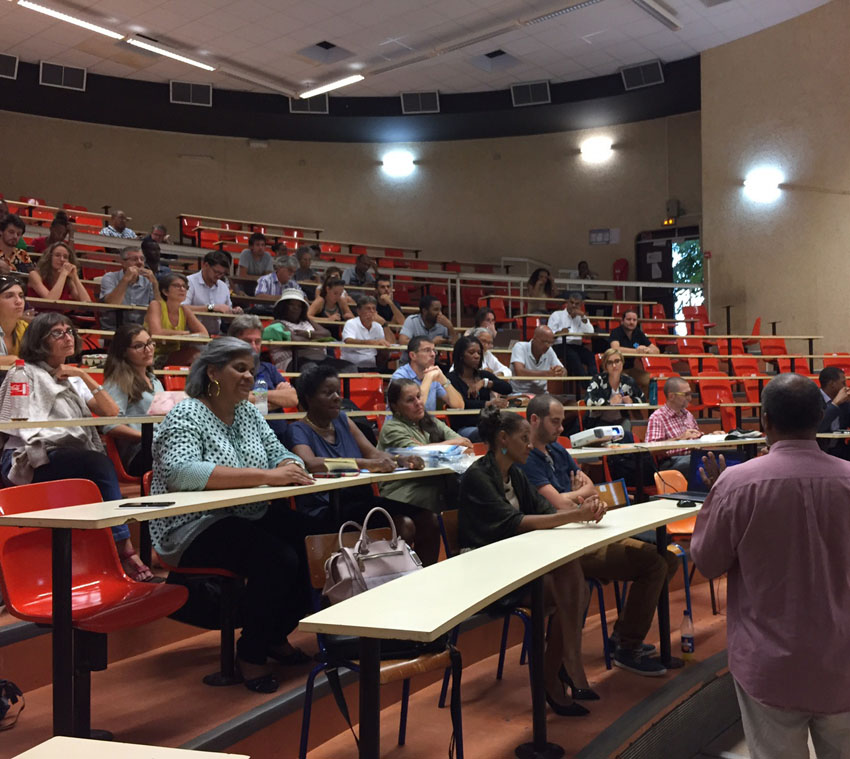 As in November 2015 in Saint Martin, a «Kozé Agoa» was organized in Martinique on January 10, the evening before the council meeting. The public was invited to the law school auditorium on the university campus for a presentation on the marine mammals of the Caribbean, the Agoa sanctuary, the CARI’MAM project (read above article), and the initiatives led by associations in Martinique. The audience was also instructed in the good practices for observation of cetaceans.
As in November 2015 in Saint Martin, a «Kozé Agoa» was organized in Martinique on January 10, the evening before the council meeting. The public was invited to the law school auditorium on the university campus for a presentation on the marine mammals of the Caribbean, the Agoa sanctuary, the CARI’MAM project (read above article), and the initiatives led by associations in Martinique. The audience was also instructed in the good practices for observation of cetaceans.On December 12, 2016, Romain Renoux participated in a meeting organized by the Collectivité to examine the procedure for Saint Martin to join the Organization of Eastern Caribbean States (OECS).
Aline Hanson presided alongside the ambassador of the OECS, and several subjects of common interest between the Collectivité and this organization were evoked. Romain Renoux, coordinator of the European BEST Project for the Caribbean islands, represented the Réserve Naturelle and presented the two BEST programs currently underway. The first comprises financing for biodiversity conservation projects, and the second the identification and spatial distribution of these zones in terms of biodiversity. Both projects apply to the European islands in the Caribbean.
Did you know that the United States and France collaborate on marine environmental issues and the management of protected marine areas (AMP)?
On January 18 & 19, 2017, the National Oceanic and Atmospheric Administration (NOAA) and the French Embassy in the United States organized «French-American Climate Talks on Oceans» - FACTO - in Virginia. The French Agency for Biodiversity was among those invited, as well as Sandrine Pivard, the new director of the SPAW-RAC. Romain Renoux, who represents the Agoa sanctuary in Saint Martin, attended via video conference and spoke about the Réserve Naturelle of Saint- Martin, the Agoa sanctuary, and the creation of an international network for those sanctuaries that protect the Caribbean marine mammals : Agoa for France, Yarari for The Netherlands, La Samana in the Dominican Republic, and Stellwagen Bank National Marine Sanctuary, run by the NOAA, in Massachusetts Bay. He also insisted on the necessity of trans-frontier cooperation between nations in order to respond to the challenges of ecological connectivity. This cooperation is advancing, notably through the CARI’MAM project (read above article) and a program that pairs the sanctuaries.
Inspired by the concept of Atlanticism, the European Commission has come up with the idea of a network of protected marine areas in all of the countries that border the Atlantic Ocean, both north and south.
Romain Renoux, coordinator of the European BEST Project for the Caribbean islands, and representative for the Agoa sanctuary for the protection of marine mammals in Saint Martin, was invited in mid-November 2016 to the first workshop concerning this project, as the European Commission hopes to get some pilot activities up and running to kick off this partnership between the various nations. He presented activities organized by Agoa, as well as those of the Réserve Naturelle in the framework of the Megara mission concerning the corridors of migration for humpback whales, as they are oblivious to frontiers. Convinced, the European Commission decided to finance a series of strategy meetings with the protected marine areas in countries already implicated in this area — France, Holland, The Dominican Republic, and the United States — as well as with those countries hoping to improve their awareness about these corridors of migration, notably Bermuda. The first of these ateliers will take place before summer 2017. The Réserve Naturelle and Agoa share an interest in advancing the protection of the humpback whales, which visit our waters part of the year, as well as educating the European Commission about this subject and eventual financing for future projects.

